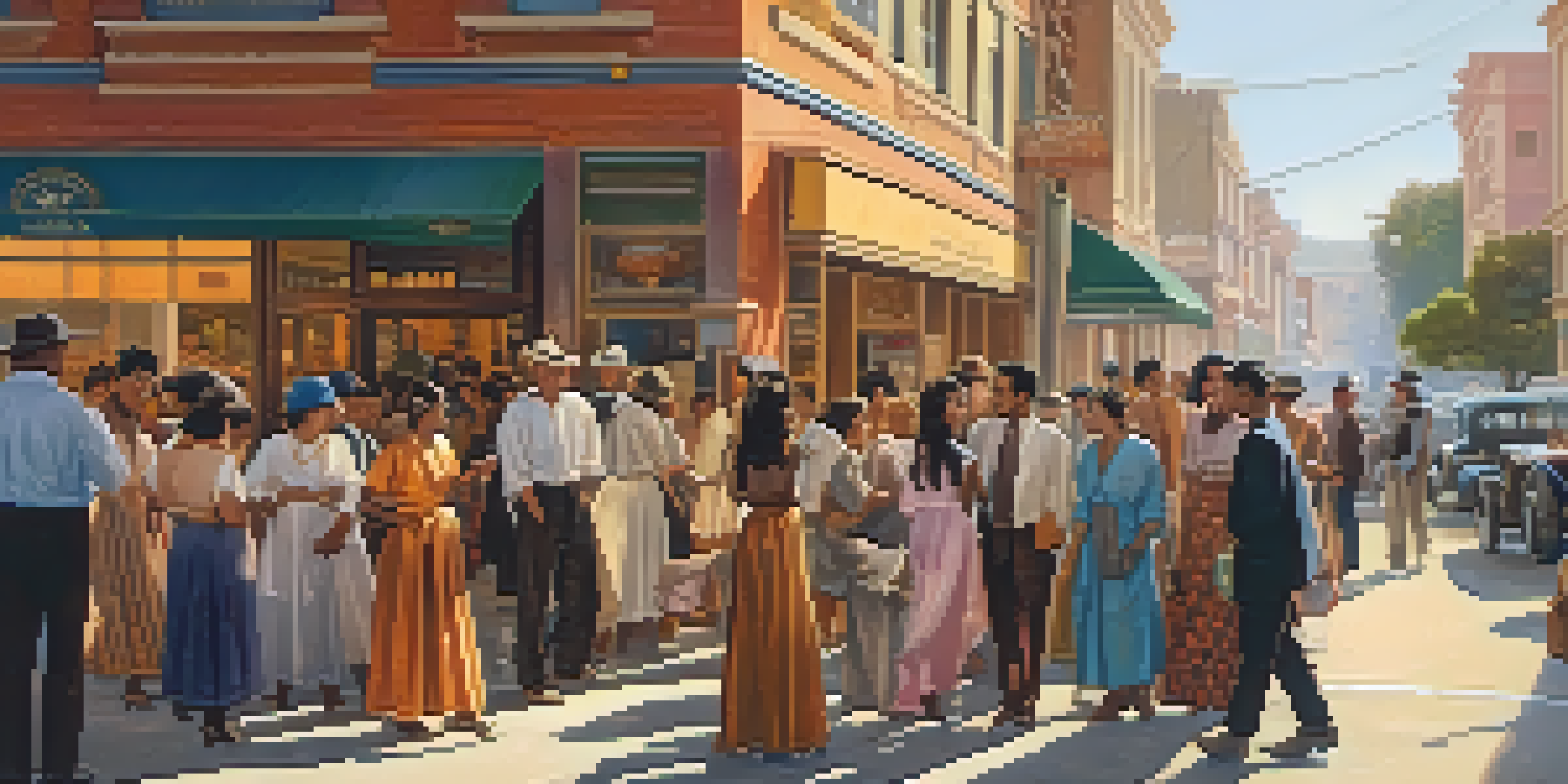The Historical Context of Immigration in California's Growth

Early Immigration Waves and California's Formation
In the mid-19th century, California became a beacon for immigrants, drawn by the promise of opportunity during the Gold Rush. This influx was not just from other states but from countries like China, Mexico, and Europe, each contributing to the state's diverse fabric. The pursuit of wealth and a better life fueled a demographic shift that would lay the groundwork for California's future. As immigrants settled, they brought unique cultures, languages, and traditions that enriched the local communities.
California is a place where we can all start anew, transforming the hopes and dreams of immigrants into a vibrant cultural tapestry.
The Gold Rush era marked a significant turning point, as the population soared from about 14,000 in 1848 to over 300,000 by 1852. This rapid growth necessitated infrastructure development, such as roads and railways, which in turn attracted even more settlers. The blend of cultures created a vibrant society, but it also sparked tensions, leading to conflicts such as the anti-Chinese sentiment that arose in the late 1800s. Despite these challenges, immigrant communities worked to establish their identities and contribute to California's economy.
By the end of the 19th century, California was beginning to emerge as a significant player in the national landscape, driven largely by its diverse immigrant population. The impact of these early waves of immigration would set the stage for California’s identity as a melting pot, where different backgrounds coexist and contribute to a collective history. This foundation would influence future immigration policies and the state’s development well into the 20th century.
The Impact of the Industrial Revolution on Immigration
The Industrial Revolution transformed California's economy, leading to an increased demand for labor in industries such as agriculture, mining, and transportation. This demand attracted waves of immigrants seeking work and a chance to improve their lives. The railroads, in particular, played a crucial role in connecting California’s resources with markets across the country, further incentivizing migration. Immigrants filled labor shortages, helping to drive economic growth during this pivotal time.

As factories and farms expanded, so did the need for a diverse workforce, which led to an influx of immigrants from various regions, including Asia, Europe, and Latin America. Each group brought distinct skills and knowledge, which enriched the local economy and culture. For instance, Chinese laborers were instrumental in constructing the Central Pacific Railroad, while agricultural fields thrived thanks to the contributions of Mexican workers. This interdependence showcased how immigration was vital to California’s industrial advancements.
Immigration Shapes California's Identity
The diverse waves of immigrants have significantly influenced California's culture, economy, and social dynamics throughout its history.
However, the rapid influx of immigrants also sparked social tensions, particularly among native-born citizens who feared job competition. This led to the establishment of immigration laws aimed at restricting certain groups, reflecting the complex interplay between economic needs and social dynamics. Nevertheless, the contributions of immigrant communities during the Industrial Revolution were undeniable, as they helped shape California into a thriving economic hub.
The Great Migration and California's Urban Centers
The Great Migration saw African Americans moving from Southern states to urban centers, including California, in search of better opportunities during the early and mid-20th century. This movement was driven by the desire to escape the oppressive conditions of the Jim Crow South and to find jobs in burgeoning cities. California's urban areas, particularly Los Angeles and San Francisco, became attractive destinations due to their economic prospects and cultural vibrancy. This migration significantly altered the demographic landscape of the state.
The story of California is a story of immigration, a story of hope and resilience that continues to shape our future.
As African Americans settled in California, they brought with them rich cultural traditions, which contributed to the state's diverse artistic and musical scenes. Jazz and blues flourished in urban neighborhoods, creating a cultural renaissance that enriched California’s identity. However, the influx also led to challenges, including housing discrimination and racial tensions, which underscored the ongoing struggle for civil rights. The resilience of these communities helped to pave the way for social change.
The Great Migration not only transformed California's cities but also influenced its political landscape, as new voices emerged to advocate for equality and justice. This period marked a significant chapter in California's history, highlighting the power of migration to shape social dynamics and push for progress. The legacy of this migration is still felt today, as California continues to celebrate its rich tapestry of cultures and communities.
Post-World War II Immigration and Economic Boom
Following World War II, California experienced a significant economic boom, driven in part by a renewed wave of immigration. Returning veterans and their families sought opportunities in the expanding job market, while immigrants from various countries, including Japan, the Philippines, and war-torn Europe, arrived seeking stability and prosperity. This post-war period was characterized by a surge in population growth, as families settled in urban and suburban areas, eager to contribute to California’s thriving economy.
The influx of skilled and unskilled laborers played a critical role in the state's rapid industrial growth, particularly in sectors like aerospace, technology, and agriculture. As the economy flourished, California became known as a land of innovation and opportunity, attracting ambitious individuals from around the globe. The diversity of the workforce not only fueled economic expansion but also fostered a spirit of creativity and collaboration that defined the state’s identity during this era.
Economic Growth Fueled by Immigrants
Various immigrant groups have played essential roles in driving California's economic development, particularly during the Industrial Revolution and post-World War II era.
However, this period also brought challenges, including housing shortages and social tensions among different cultural groups. The government and community organizations worked to address these issues, promoting policies that aimed to integrate immigrants into society. Ultimately, the post-World War II immigration wave cemented California’s status as a diverse and dynamic state, setting the stage for its continued growth and evolution in the decades to come.
The Role of Mexican Immigration in Shaping California
Mexican immigration has played a pivotal role in California's development, particularly given the historical ties between the two regions. Following the Mexican-American War in the mid-1800s, many Mexicans sought opportunities in California, contributing significantly to agriculture and labor sectors. As the state grew, so did the Mexican community, which became integral to California’s economy and culture. Their influence can be seen in everything from cuisine to festivals, enriching the state’s identity.
The Bracero Program, established during World War II, further solidified the connection between Mexico and California. This program allowed Mexican laborers to work temporarily in the U.S., addressing labor shortages while providing economic opportunities for workers. Many of these immigrants chose to stay after their contracts ended, leading to the establishment of vibrant communities. The legacy of this program can still be felt today, as Mexican culture continues to thrive in California.
Despite their contributions, Mexican immigrants have often faced challenges, including discrimination and immigration policy hurdles. However, their resilience and determination have led to a rich cultural tapestry that defines much of California today. The ongoing dialogue around immigration reform and community support reflects the complex relationship between California and its Mexican population, highlighting both the challenges and triumphs of this enduring connection.
Contemporary Immigration Trends and Challenges
In recent decades, California has continued to be a destination for immigrants from around the world, each group adding to the state's rich diversity. This contemporary wave includes individuals from Central America, Asia, and various other regions, drawn by opportunities in technology, agriculture, and education. However, these trends are accompanied by challenges, including debates over immigration policies, border security, and the impact on local communities. The conversation around immigration often reflects broader societal issues, creating a complex landscape.
As California navigates these contemporary challenges, immigrant communities remain vital to the state's economy and cultural vibrancy. From tech entrepreneurs launching startups in Silicon Valley to farmworkers sustaining the agricultural industry, immigrants play essential roles in various sectors. Furthermore, the contributions of immigrant populations help to foster innovation and creativity, driving California's reputation as a global leader in various fields.
Challenges Amidst Cultural Richness
Despite their contributions, immigrant communities in California have faced social tensions and discrimination, highlighting the ongoing struggles for equity and inclusion.
The ongoing discussions surrounding immigration reform and the treatment of undocumented individuals have sparked movements advocating for social justice and equal rights. These efforts reflect the resilience of immigrant communities and their determination to secure a place in California’s future. As the state grapples with these challenges, it continues to celebrate its identity as a land of opportunity, shaped by the stories and struggles of those who have come seeking a better life.
California's Future: The Continuing Legacy of Immigration
As California looks to the future, the legacy of immigration remains a cornerstone of its identity and growth. The state’s diverse population continues to shape its culture, economy, and political landscape, illustrating the enduring impact of those who have come seeking opportunity. California’s ability to adapt and thrive amid changing demographics is a testament to the strength and resilience of its communities. The stories of immigrants, past and present, reflect a journey of hope and determination that resonates throughout the state.
Educational institutions and community organizations are increasingly focusing on the importance of inclusivity and multiculturalism, recognizing the value of diverse perspectives. This commitment to embracing diversity not only enriches the educational experience but also fosters a sense of belonging among all residents. By investing in the future of immigrant communities, California is laying the groundwork for continued innovation and progress.

In conclusion, the historical context of immigration in California highlights a complex narrative filled with triumphs and challenges. As the state moves forward, it will be essential to honor the contributions of immigrants and work towards policies that promote equity and inclusion. The future of California is inextricably linked to its history of immigration, and understanding this relationship will be crucial in shaping a prosperous and harmonious society.